Boosting the Piezoelectric Response and Interfacial Compatibility in Flexible Piezoelectric Composites via DET-Doping BT Nanoparticles
Abstract
:1. Introduction
2. Materials and Methods
2.1. Materials
2.2. Modification of BTO Nanoparticles via DET
2.3. Preparation of Electrospinning Fibers
2.4. Characterizations
3. Results and Discussion
4. Conclusions
Supplementary Materials
Author Contributions
Funding
Institutional Review Board Statement
Informed Consent Statement
Data Availability Statement
Conflicts of Interest
References
- Xie, Y.; Wu, X.; Huang, X.; Liang, Q.; Deng, S.; Wu, Z.; Yao, Y.; Lu, L. A Deep Learning-Enabled Skin-Inspired Pressure Sensor for Complicated Recognition Tasks with Ultralong Life. Research 2023, 6, 0157. [Google Scholar] [CrossRef] [PubMed]
- Xiong, X.; Liang, J.; Wu, W. Principle and recent progress of triboelectric pressure sensors for wearable applications. Nano Energy 2023, 113, 108542. [Google Scholar] [CrossRef]
- Zhang, S.; Pang, J.; Li, Y.; Yang, F.; Gemming, T.; Wang, K.; Wang, X.; Peng, S.; Liu, X.; Chang, B.; et al. Emerging Internet of Things driven carbon nanotubes-based devices. Nano Res. 2022, 15, 4613. [Google Scholar] [CrossRef]
- Zhang, Y.; Jeong, C.K.; Wang, J.; Chen, X.; Choi, K.H.; Chen, L.-Q.; Chen, W.; Zhang, Q.M.; Wang, Q. Hydrogel Ionic Diodes toward Harvesting Ultralow-Frequency Mechanical Energy. Adv. Mater. 2021, 33, 2103056. [Google Scholar] [CrossRef]
- Zhang, Y.; Kim, H.; Wang, Q.; Jo, W.; Kingon, A.I.; Kim, S.-H.; Jeong, C.K. Progress in lead-free piezoelectric nanofiller materials and related composite nanogenerator devices. Nanoscale Adv. 2020, 2, 3131. [Google Scholar] [CrossRef]
- Wan, X.; Wang, Z.; Zhao, X.; Hu, Q.; Li, Z.; Wang, Z.L.; Li, L. Flexible and highly piezoelectric nanofibers with organic–inorganic coaxial structure for self-powered physiological multimodal sensing. Chem. Eng. J. 2023, 451, 139077. [Google Scholar] [CrossRef]
- Liang, B.; Huang, B.; He, J.; Yang, R.; Zhao, C.; Yang, B.-R.; Cao, A.; Tang, Z.; Gui, X. Direct stamping multifunctional tactile sensor for pressure and temperature sensing. Nano Res. 2022, 15, 3614. [Google Scholar] [CrossRef]
- Zang, Y.; Zhang, F.; Di, C.; Zhu, D. Advances of flexible pressure sensors toward artificial intelligence and health care applications. Mater. Horiz. 2015, 2, 140. [Google Scholar] [CrossRef]
- Shi, Z.; Meng, L.; Shi, X.; Li, H.; Zhang, J.; Sun, Q.; Liu, X.; Chen, J.; Liu, S. Morphological Engineering of Sensing Materials for Flexible Pressure Sensors and Artificial Intelligence Applications. Nano-Micro Lett. 2022, 14, 141. [Google Scholar] [CrossRef]
- Mariello, M.; Qualtieri, A.; Mele, G.; De Vittorio, M. Metal-Free Multilayer Hybrid PENG Based on Soft Electrospun/-Sprayed Membranes with Cardanol Additive for Harvesting Energy from Surgical Face Masks. ACS Appl. Mater. Interfaces 2021, 13, 20606. [Google Scholar] [CrossRef] [PubMed]
- Su, H.; Wang, X.; Li, C.; Wang, Z.; Wu, Y.; Zhang, J.; Zhang, Y.; Zhao, C.; Wu, J.; Zheng, H. Enhanced energy harvesting ability of polydimethylsiloxane-BaTiO3-based flexible piezoelectric nanogenerator for tactile imitation application. Nano Energy 2021, 83, 105809. [Google Scholar] [CrossRef]
- Zhang, Y.; Wu, M.; Zhu, Q.; Wang, F.; Su, H.; Li, H.; Diao, C.; Zheng, H.; Wu, Y.; Wang, Z.L. Performance Enhancement of Flexible Piezoelectric Nanogenerator via Doping and Rational 3D Structure Design For Self-Powered Mechanosensational System. Adv. Funct. Mater. 2019, 29, 1904259. [Google Scholar] [CrossRef]
- Wang, Z.; Cheng, J.; Hu, R.; Yuan, X.; Yu, Z.; Xu, X.; Wang, F.; Dong, J.; Gong, R.; Dong, S.; et al. An approach combining additive manufacturing and dielectrophoresis for 3D-structured flexible lead-free piezoelectric composites for electromechanical energy conversion. J. Mater. Chem. A 2021, 9, 26767. [Google Scholar] [CrossRef]
- Yan, M.; Zhong, J.; Liu, S.; Xiao, Z.; Yuan, X.; Zhai, D.; Zhou, K.; Li, Z.; Zhang, D.; Bowen, C.; et al. Flexible pillar-base structured piezocomposite with aligned porosity for piezoelectric energy harvesting. Nano Energy 2021, 88, 106278. [Google Scholar] [CrossRef]
- Yan, M.; Liu, S.; Liu, Y.; Xiao, Z.; Yuan, X.; Zhai, D.; Zhou, K.; Wang, Q.; Zhang, D.; Bowen, C.; et al. Flexible PVDF–TrFE Nanocomposites with Ag-decorated BCZT Heterostructures for Piezoelectric Nanogenerator Applications. ACS Appl. Mater. Interfaces 2022, 14, 53261. [Google Scholar] [CrossRef]
- Ribeiro, C.; Correia, D.M.; Ribeiro, S.; Sencadas, V.; Botelho, G.; Lanceros-Méndez, S. Piezoelectric poly(vinylidene fluoride) microstructure and poling state in active tissue engineering. Eng. Life Sci. 2015, 15, 351. [Google Scholar] [CrossRef]
- Liu, X.; Shang, Y.; Liu, J.; Shao, Z.; Zhang, C. 3D Printing-Enabled In-Situ Orientation of BaTi2O5 Nanorods in β-PVDF for High-Efficiency Piezoelectric Energy Harvesters. ACS Appl. Mater. Interfaces 2022, 14, 13361. [Google Scholar] [CrossRef] [PubMed]
- Zhang, H.; Wu, Y.; Jin, W.; Chen, W.; Zhang, Y. Dramatically enhanced energy harvesting capability in sandwich-structure modulated piezoelectric nanocomposites. Mater. Sci. Semicond. Process. 2023, 155, 107260. [Google Scholar] [CrossRef]
- Zhang, H.; Jeong, C.K.; Shen, Z.; Wang, J.; Sun, H.; Jian, Z.; Chen, W.; Zhang, Y. Ultrahigh augmentation of flexible composite-based piezoelectric energy harvesting efficiency via polymer-impregnated nanoparticles network within 3D cellulose scaffold. Compos. Part B Eng. 2022, 236, 109813. [Google Scholar] [CrossRef]
- Zhang, Y.; Jeong, C.K.; Wang, J.; Sun, H.; Li, F.; Zhang, G.; Chen, L.-Q.; Zhang, S.; Chen, W.; Wang, Q. Flexible energy harvesting polymer composites based on biofibril-templated 3-dimensional interconnected piezoceramics. Nano Energy 2018, 50, 35. [Google Scholar] [CrossRef]
- Saxena, P.; Shukla, P. A comprehensive review on fundamental properties and applications of poly(vinylidene fluoride) (PVDF). Adv. Compos. Hybrid Mater. 2021, 4, 8. [Google Scholar] [CrossRef]
- Chen, H.; Zhou, L.; Fang, Z.; Wang, S.; Yang, T.; Zhu, L.; Hou, X.; Wang, H.; Wang, Z.L. Piezoelectric Nanogenerator Based on In Situ Growth All-Inorganic CsPbBr3 Perovskite Nanocrystals in PVDF Fibers with Long-Term Stability. Adv. Funct. Mater. 2021, 31, 2011073. [Google Scholar] [CrossRef]
- Ribeiro, C.; Costa, C.M.; Correia, D.M.; Nunes-Pereira, J.; Oliveira, J.; Martins, P.; Gonçalves, R.; Cardoso, V.F.; Lanceros-Méndez, S. Electroactive poly(vinylidene fluoride)-based structures for advanced applications. Nat. Protoc. 2018, 13, 681. [Google Scholar] [CrossRef] [PubMed]
- Lu, L.; Ding, W.; Liu, J.; Yang, B. Flexible PVDF based piezoelectric nanogenerators. Nano Energy 2020, 78, 105251. [Google Scholar] [CrossRef]
- Furukawa, T. Ferroelectric properties of vinylidene fluoride copolymers. Phase Transit. 1989, 18, 143. [Google Scholar] [CrossRef]
- Pei, H.; Shi, S.; Chen, Y.; Xiong, Y.; Lv, Q. Combining Solid-State Shear Milling and FFF 3D-Printing Strategy to Fabricate High-Performance Biomimetic Wearable Fish-Scale PVDF-Based Piezoelectric Energy Harvesters. ACS Appl. Mater. Interfaces 2022, 14, 15346. [Google Scholar] [CrossRef]
- Liu, Z.; Li, S.; Zhu, J.; Mi, L.; Zheng, G. Fabrication of β-Phase-Enriched PVDF Sheets for Self-Powered Piezoelectric Sensing. ACS Appl. Mater. Interfaces 2022, 14, 11854. [Google Scholar] [CrossRef] [PubMed]
- Wang, L.; Yu, Y.; Zhao, X.; Zhang, Z.; Yuan, X.; Cao, J.; Meng, W.; Ye, L.; Lin, W.; Wang, G. A Biocompatible Self-Powered Piezoelectric Poly(vinyl alcohol)-Based Hydrogel for Diabetic Wound Repair. ACS Appl. Mater. Interfaces 2022, 14, 46273. [Google Scholar] [CrossRef]
- Liu, H.; Wang, Z.; Xie, J.; Guo, C.; Hu, W. Control over the complex phase evolutions for ultrahigh dielectric energy storage in pure poly(vinylidene fluoride) films. J. Energy Storage 2022, 55, 105618. [Google Scholar] [CrossRef]
- Pariy, I.O.; Ivanova, A.A.; Shvartsman, V.V.; Lupascu, D.C.; Sukhorukov, G.B.; Ludwig, T.; Bartasyte, A.; Mathur, S.; Surmeneva, M.A.; Surmenev, R.A. Piezoelectric Response in Hybrid Micropillar Arrays of Poly(Vinylidene Fluoride) and Reduced Graphene Oxide. Polymers 2019, 11, 1065. [Google Scholar] [CrossRef]
- Liu, Z.H.; Pan, C.T.; Lin, L.W.; Huang, J.C.; Ou, Z.Y. Direct-write PVDF nonwoven fiber fabric energy harvesters via the hollow cylindrical near-field electrospinning process. Smart Mater. Struct. 2013, 23, 025003. [Google Scholar] [CrossRef]
- Kim, Y.K.; Hwang, S.-H.; Seo, H.-J.; Jeong, S.M.; Lim, S.K. Effects of biomimetic cross-sectional morphology on the piezoelectric properties of BaTiO3 nanorods-contained PVDF fibers. Nano Energy 2022, 97, 107216. [Google Scholar] [CrossRef]
- Salimi, A.; Yousefi, A.A. Analysis Method: FTIR studies of β-phase crystal formation in stretched PVDF films. Polym. Test. 2003, 22, 699. [Google Scholar] [CrossRef]
- Li, H.; Song, H.; Long, M.; Saeed, G.; Lim, S. Mortise–tenon joint structured hydrophobic surface-functionalized barium titanate/polyvinylidene fluoride nanocomposites for printed self-powered wearable sensors. Nanoscale 2021, 13, 2542. [Google Scholar] [CrossRef] [PubMed]
- Defebvin, J.; Barrau, S.; Lyskawa, J.; Woisel, P.; Lefebvre, J.-M. Influence of nitrodopamine-functionalized barium titanate content on the piezoelectric response of poly(vinylidene fluoride) based polymer-ceramic composites. Compos. Sci. Technol. 2017, 147, 16. [Google Scholar] [CrossRef]
- Kim, J.-H.; Park, D.-H.; Jang, J.-S.; Shin, J.-H.; Kim, M.-C.; Kim, S.-B.; Moon, S.-H.; Lee, S.-N.; Park, K.-W. High-performance free-standing hybrid solid electrolyte membrane combined with Li6.28Al0.24La3Zr2O12 and hexagonal-BN for all-solid-state lithium-based batteries. Chem. Eng. J. 2022, 446, 137035. [Google Scholar] [CrossRef]
- Han, C.; Zhang, H.; Chen, Q.; Li, T.; Kong, L.; Zhao, H.; He, L. A directional piezoelectric sensor based on anisotropic PVDF/MXene hybrid foam enabled by unidirectional freezing. Chem. Eng. J. 2022, 450 Pt 3, 138280. [Google Scholar] [CrossRef]
- Shi, K.; Chai, B.; Zou, H.; Shen, P.; Sun, B.; Jiang, P.; Shi, Z.; Huang, X. Interface induced performance enhancement in flexible BaTiO3/PVDF-TrFE based piezoelectric nanogenerators. Nano Energy 2021, 80, 105515. [Google Scholar] [CrossRef]
- Kim, J.; Jang, M.; Jeong, G.; Yu, S.; Park, J.; Lee, Y.; Cho, S.; Yeom, J.; Lee, Y.; Choe, A.; et al. MXene-enhanced β-phase crystallization in ferroelectric porous composites for highly-sensitive dynamic force sensors. Nano Energy 2021, 89, 106409. [Google Scholar] [CrossRef]
- Yu, Y.; Xu, P.; Du, H.; Zhou, Q.; Wu, Y.; Hao, Y.; Ren, J.; Pang, Z.; Chen, Z.; Han, S. Surface Modification of NiOx Layer with Versatile Coupling Agent Enables Enhanced Performance and Stability of Inverted Perovskite Solar Cells. Sol. RRL 2023, 7, 2201047. [Google Scholar] [CrossRef]
- Cheng, G.; Tong, B.; Tang, Z.; Yu, X.; Wang, H.; Ding, G. Surface functionalization of coal powder with different coupling agents for potential applications in organic materials. Appl. Surf. Sci. 2014, 313, 954. [Google Scholar] [CrossRef]
- Wan, X.; Zhan, Y.; Long, Z.; Zeng, G.; He, Y. Core@double-shell structured magnetic halloysite nanotube nano-hybrid as efficient recyclable adsorbent for methylene blue removal. Chem. Eng. J. 2017, 330, 491. [Google Scholar] [CrossRef]
- Li, H.; Lim, S. Screen Printing of Surface-Modified Barium Titanate/Polyvinylidene Fluoride Nanocomposites for High-Performance Flexible Piezoelectric Nanogenerators. Nanomaterials 2022, 12, 2910. [Google Scholar] [CrossRef] [PubMed]
- Gregorio, R.; Cestari, M., Jr. Effect of crystallization temperature on the crystalline phase content and morphology of poly(vinylidene fluoride). J. Polym. Sci. Part B Polym. Phys. 1994, 32, 859. [Google Scholar] [CrossRef]
- Martins, P.; Lopes, A.C.; Lanceros-Mendez, S. Electroactive phases of poly(vinylidene fluoride): Determination, processing and applications. Prog. Polym. Sci. 2014, 39, 683. [Google Scholar] [CrossRef]
- Su, Y.; Li, W.; Cheng, X.; Zhou, Y.; Yang, S.; Zhang, X.; Chen, C.; Yang, T.; Pan, H.; Xie, G. High-performance piezoelectric composites via β phase programming. Nat. Commun. 2022, 13, 4867. [Google Scholar] [CrossRef]
- Yang, M.; Guo, Z.; Li, L.-N.; Huang, Y.-Y.; Liu, J.-H.; Zhou, Q.; Chen, X.; Huang, X.-J. Electrochemical determination of arsenic(III) with ultra-high anti-interference performance using Au–Cu bimetallic nanoparticles. Sens. Actuators B Chem. 2016, 231, 70. [Google Scholar] [CrossRef]
- Evans, G.; Duong, G.V.; Ingleson, M.J.; Xu, Z.; Jones, J.T.A.; Khimyak, Y.Z.; Claridge, J.B.; Rosseinsky, M.J. Chemical Bonding Assembly of Multifunctional Oxide Nanocomposites. Adv. Funct. Mater. 2010, 20, 231. [Google Scholar] [CrossRef]
- Nichols, W.W. Clinical measurement of arterial stiffness obtained from noninvasive pressure waveforms. Am. J. Hypertens. 2005, 18, 3S. [Google Scholar] [CrossRef]
- Guan, X.; Xu, B.; Gong, J. Hierarchically architected polydopamine modified BaTiO3@P(VDF-TrFE) nanocomposite fiber mats for flexible piezoelectric nanogenerators and self-powered sensors. Nano Energy 2020, 70, 104516. [Google Scholar] [CrossRef]
- Su, Y.; Li, W.; Yuan, L.; Chen, C.; Pan, H.; Xie, G.; Conta, G.; Ferrier, S.; Zhao, X.; Chen, G.; et al. Piezoelectric fiber composites with polydopamine interfacial layer for self-powered wearable biomonitoring. Nano Energy 2021, 89, 106321. [Google Scholar] [CrossRef]
- Mirjalali, S.; Bagherzadeh, R.; Varposhti, A.M.; Asadnia, M.; Huang, S.; Chang, W.; Peng, S.; Wang, C.-H.; Wu, S. Enhanced Piezoelectricity of PVDF-TrFE Nanofibers by Intercalating with Electrosprayed BaTiO3. ACS Appl. Mater. Interfaces 2023, 15, 41806–41816. [Google Scholar] [CrossRef] [PubMed]
- Wang, L.; Cheng, T.; Lian, W.; Zhang, M.; Lu, B.; Dong, B.; Tan, K.; Liu, C.; Shen, C. Flexible layered cotton cellulose-based nanofibrous membranes for piezoelectric energy harvesting and self-powered sensing. Carbohydr. Polym. 2022, 275, 118740. [Google Scholar] [CrossRef] [PubMed]
- Chen, X.; Li, X.; Shao, J.; An, N.; Tian, H.; Wang, C.; Han, T.; Wang, L.; Lu, B. High-Performance Piezoelectric Nanogenerators with Imprinted P(VDF-TrFE)/BaTiO3 Nanocomposite Micropillars for Self-Powered Flexible Sensors. Small 2017, 13, 1604245. [Google Scholar] [CrossRef] [PubMed]
- Le, J.; Lv, F.; Lin, J.; Wu, Y.; Ren, Z.; Zhang, Q.; Dong, S.; Luo, J.; Shi, J.; Chen, R.; et al. Novel Sandwich-Structured Flexible Composite Films with Enhanced Piezoelectric Performance. ACS Appl. Mater. Interfaces 2024, 16, 1492–1501. [Google Scholar] [CrossRef] [PubMed]
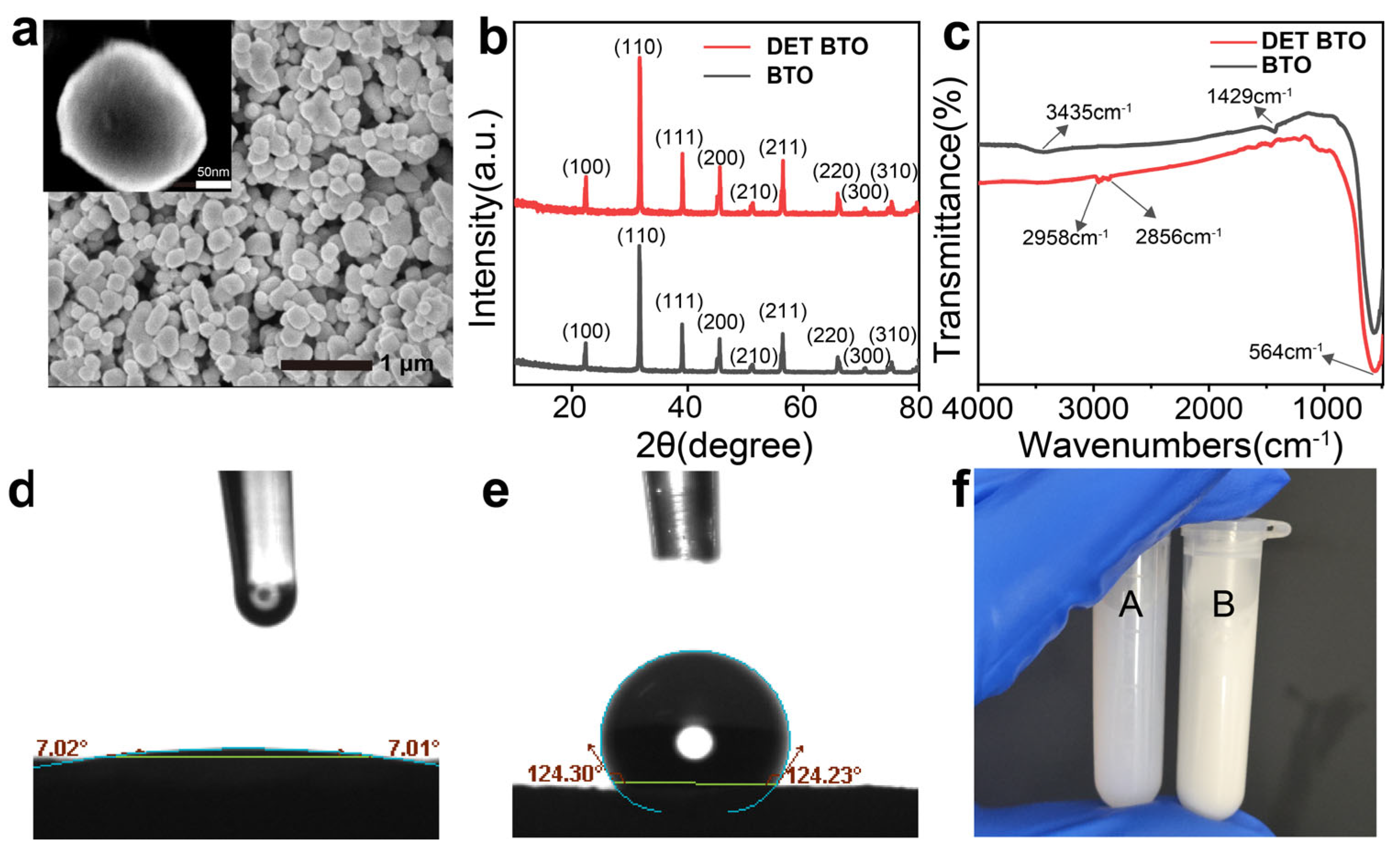
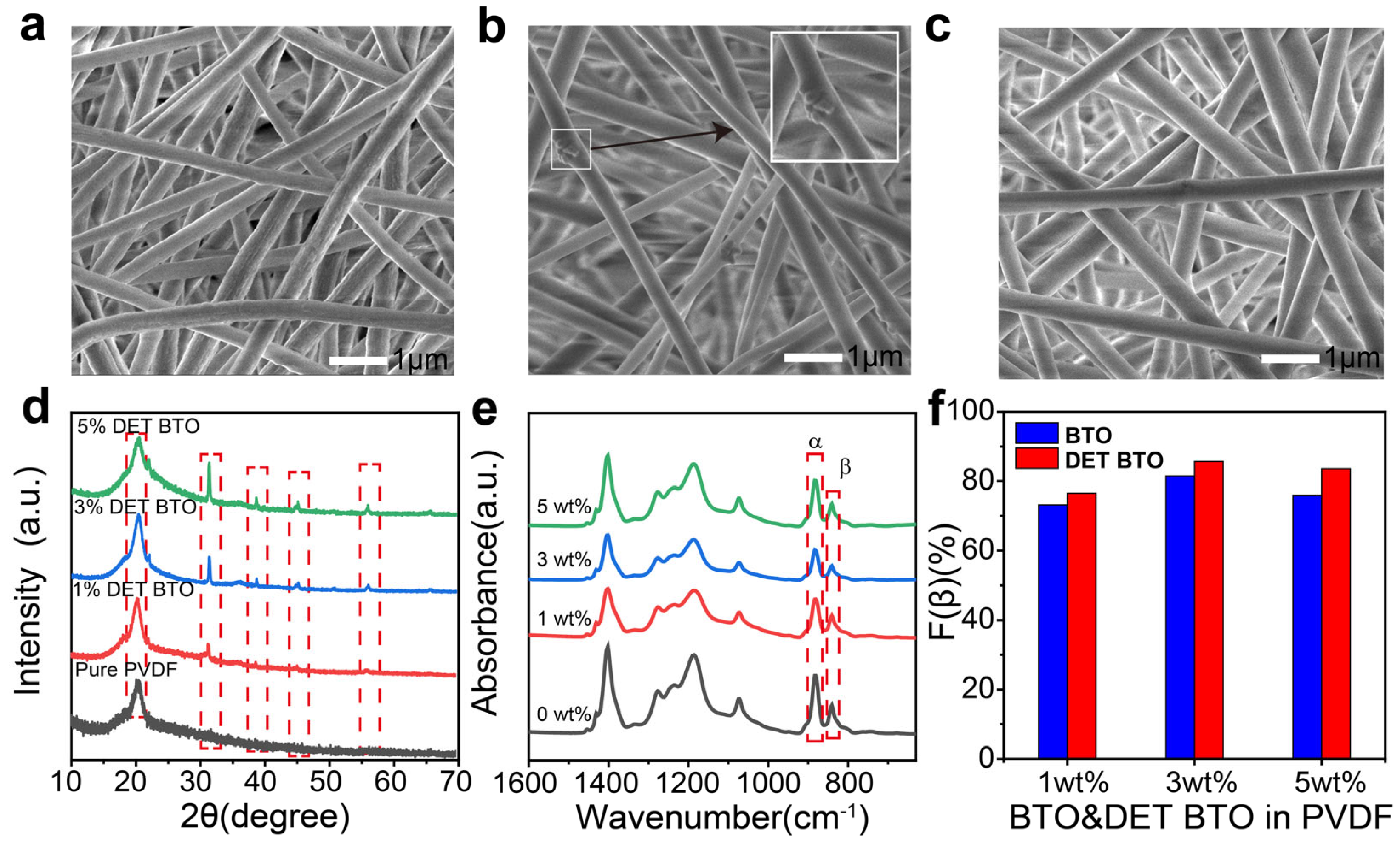
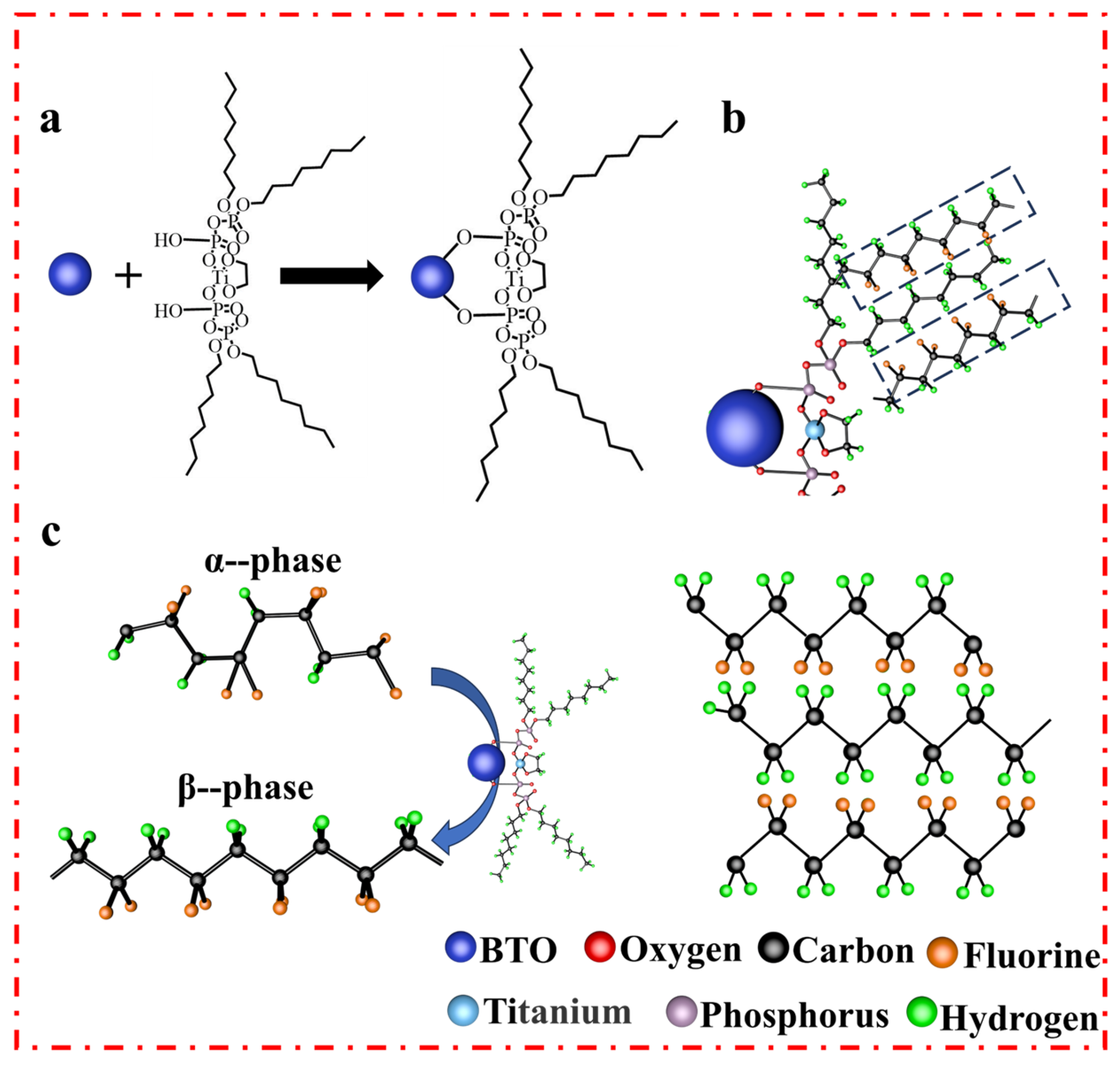
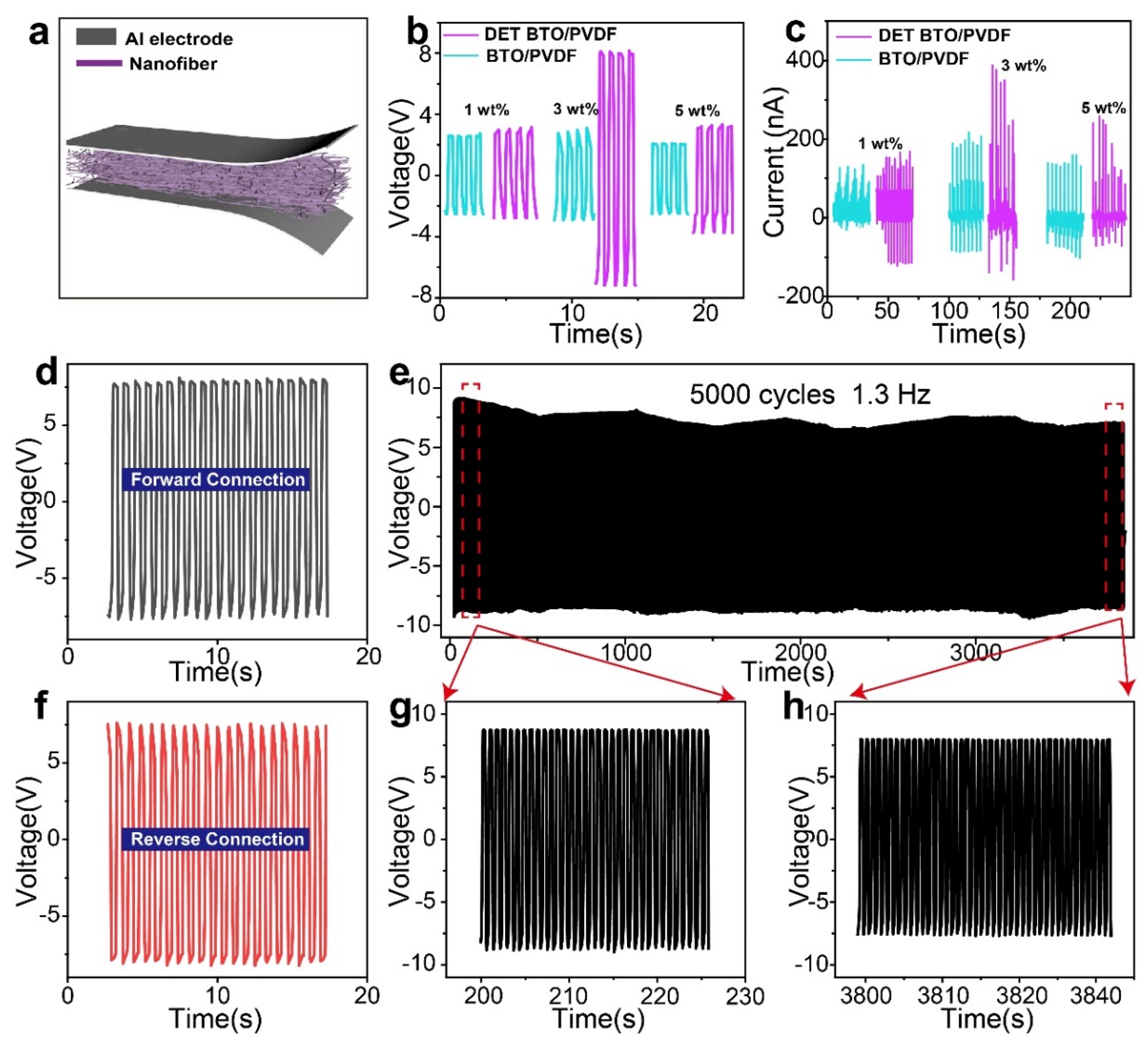
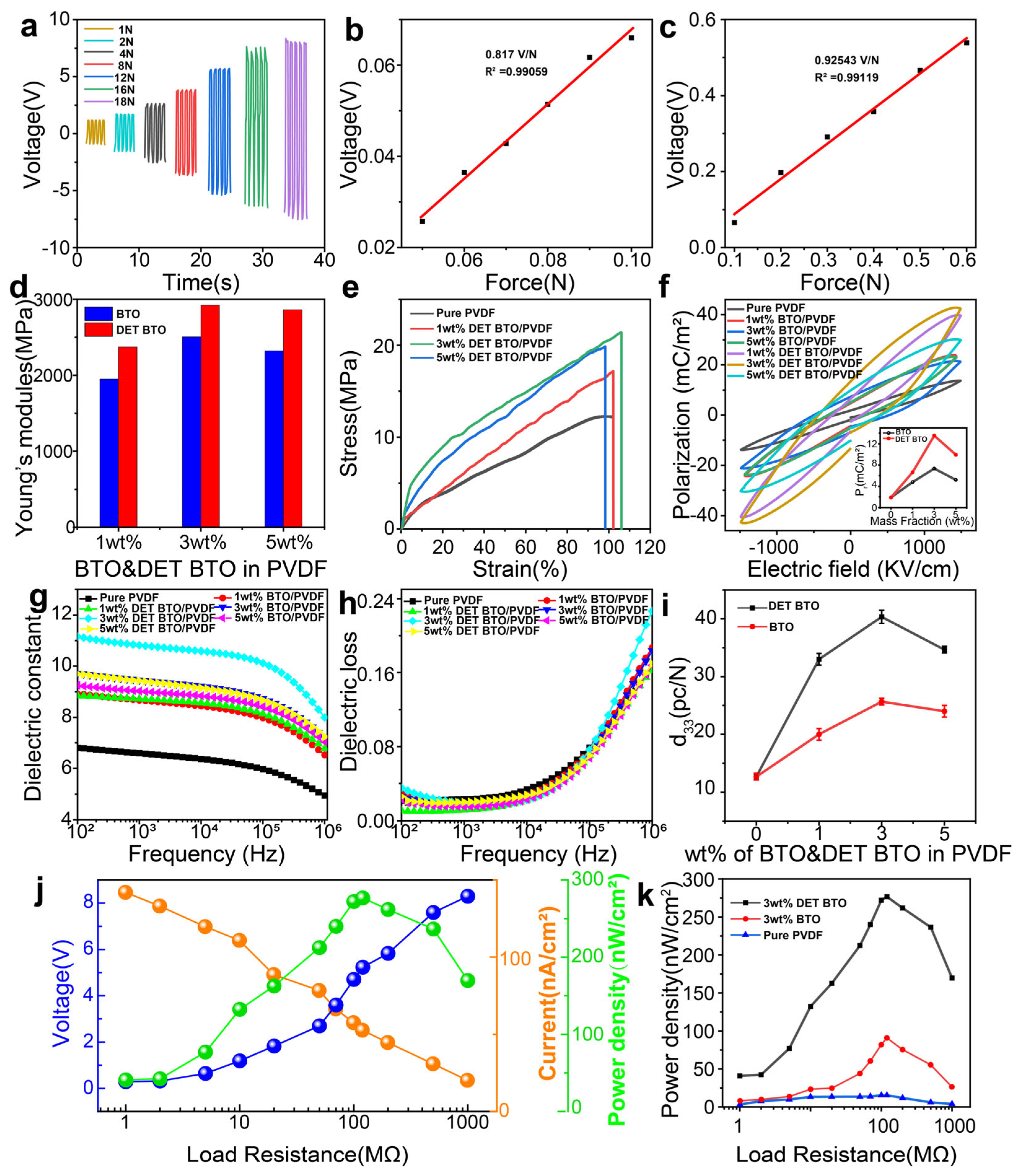
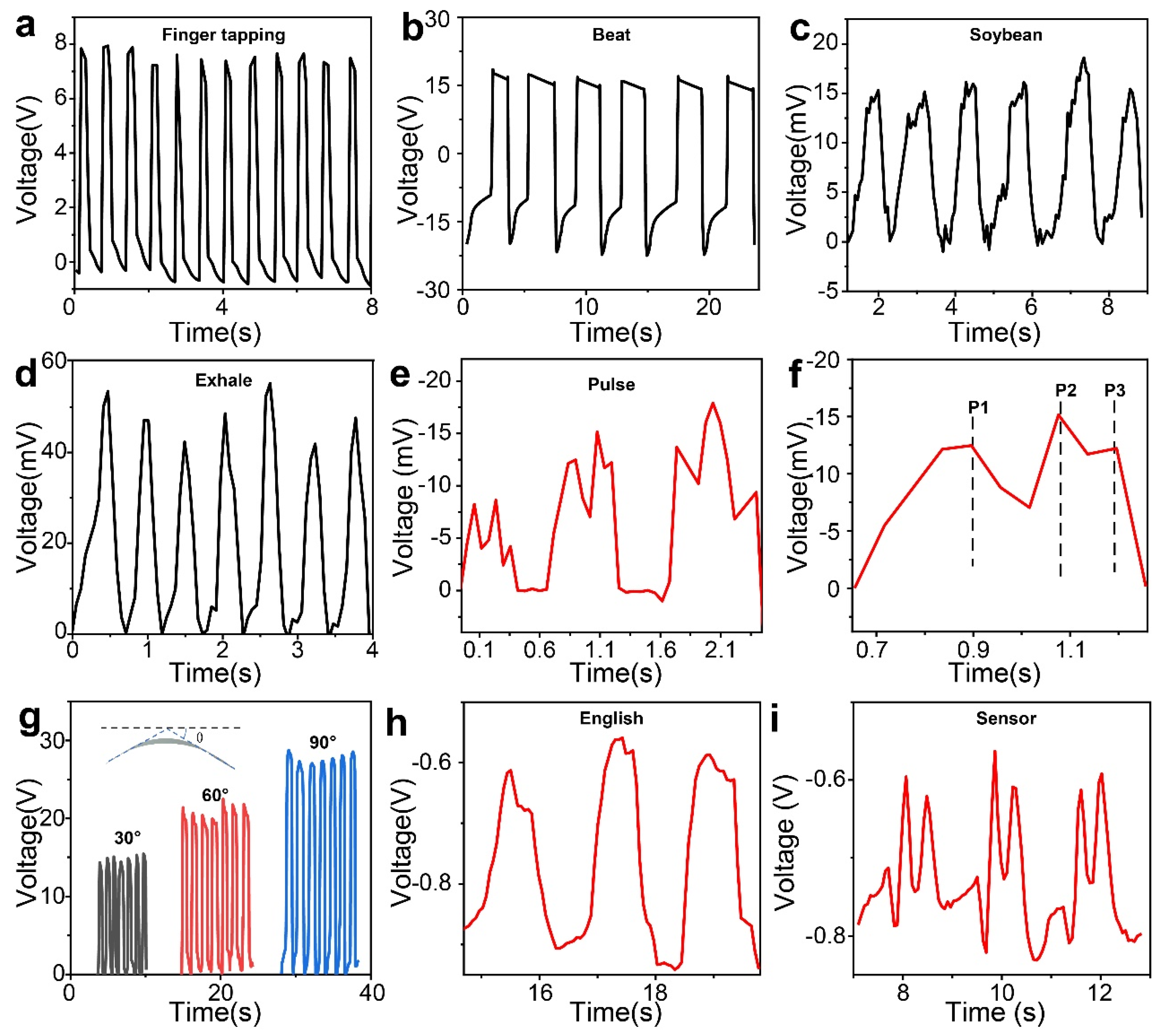
Disclaimer/Publisher’s Note: The statements, opinions and data contained in all publications are solely those of the individual author(s) and contributor(s) and not of MDPI and/or the editor(s). MDPI and/or the editor(s) disclaim responsibility for any injury to people or property resulting from any ideas, methods, instructions or products referred to in the content. |
© 2024 by the authors. Licensee MDPI, Basel, Switzerland. This article is an open access article distributed under the terms and conditions of the Creative Commons Attribution (CC BY) license (https://creativecommons.org/licenses/by/4.0/).
Share and Cite
Liu, L.; Zhang, H.; Zhou, S.; Du, C.; Liu, M.; Zhang, Y. Boosting the Piezoelectric Response and Interfacial Compatibility in Flexible Piezoelectric Composites via DET-Doping BT Nanoparticles. Polymers 2024, 16, 743. https://doi.org/10.3390/polym16060743
Liu L, Zhang H, Zhou S, Du C, Liu M, Zhang Y. Boosting the Piezoelectric Response and Interfacial Compatibility in Flexible Piezoelectric Composites via DET-Doping BT Nanoparticles. Polymers. 2024; 16(6):743. https://doi.org/10.3390/polym16060743
Chicago/Turabian StyleLiu, Liming, Hongjian Zhang, Shengyang Zhou, Changzhou Du, Ming Liu, and Yong Zhang. 2024. "Boosting the Piezoelectric Response and Interfacial Compatibility in Flexible Piezoelectric Composites via DET-Doping BT Nanoparticles" Polymers 16, no. 6: 743. https://doi.org/10.3390/polym16060743





